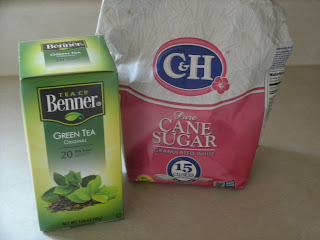Kiribati
The last stop I have planned is Kiribati. This republic of 33 coral atolls and islands in the central Pacific straddle both the equator and the international date line. There are several island groupings (Gilbert, Banaba, Line, and Phoenix islands) in this republic although the majority of the population lives on the Gilbert islands. Rising ocean levels from global warming are threatening these islands where people mainly depend on fishing and growing bananas, breadfruit, papaws, and taro. In my research, I found mention that tea is popular and is readily available at bars and restaurants. I didn't find anything specific about what type of tea they like, but the picture looked like it was green tea. Contrary to the popular pictures of "green" tea on the internet, the liquid made by steeping green tea leaves is not bright green. It's more of a bright yellow.
So for Kiribati, I thought I would explore green tea further. My first reference is the book "How to Make Tea the Science Behind the Leaf" by Brian R Keating, and Kim Long. According to them, green tea is mainly produced in China, Japan, Korea, and parts of Southeast Asia. Overall this seems to be true. My Kenyan green tea is specialty product, and a rarity in Kenyan teas. Obviously green tea is made in small quantities in other parts of the world, but that list seems to be accurate overall. They also state that most green teas are harvested between March and May. Interestingly enough, green tea was what was dumped into Boston Harbor in 1773 since black tea didn't rise to popularity in the US until the 1800s.
I found a great chart showing the steps used to make different kinds of tea. All varieties of tea start with harvesting, withering, and enzyme kill by baking, steaming, or panfrying. Basically this is heating the leaf for 60 seconds or less to stop enzyme action. White tea progresses from there to rolling and drying. Green tea then lists panfrying for Chinese teas and steaming for Japanese style greens. I'm not sure why this is listed again. It may be that it happens for longer, or for multiple times as I saw in a video about making Dragon's well tea. I also think that is a broad generalization of the differences between Chinese and Japanese teas. Ryokucha green tea is a pan fired tea from Japan, and there are certainly Chinese green teas that are not panfried because the processes used create a distinct looking tea leaf. Rolling is listed as the next step (although panfried leaves remain flat, not rolled), and drying happens last.
While the leaves produced by this process look green, the liquor they produce is not. The only green tea I can think of that is actually supposed to look green after it is made is matcha because the leaf powder is incorporated in the drink. I find that some bagged teas like to include matcha in their blends. I'm not sure what purpose it serves in their blends other than to make them sound healthier or more prestigious. They obviously depend on the general public not understanding how matcha is traditionally consumed. Oh well.
I'll leave you with one last picture of my kitty bookmark.
While it is finished, I'm still working on taking the pins out. So far I have freed the tail, and the very bottom of the cat. I should have my cat off the pillow by the end of next week.





That's a cool bookmark.
ReplyDeleteThanks. As with real cats, lace ones also take a while to coax off of a pillow.
Delete